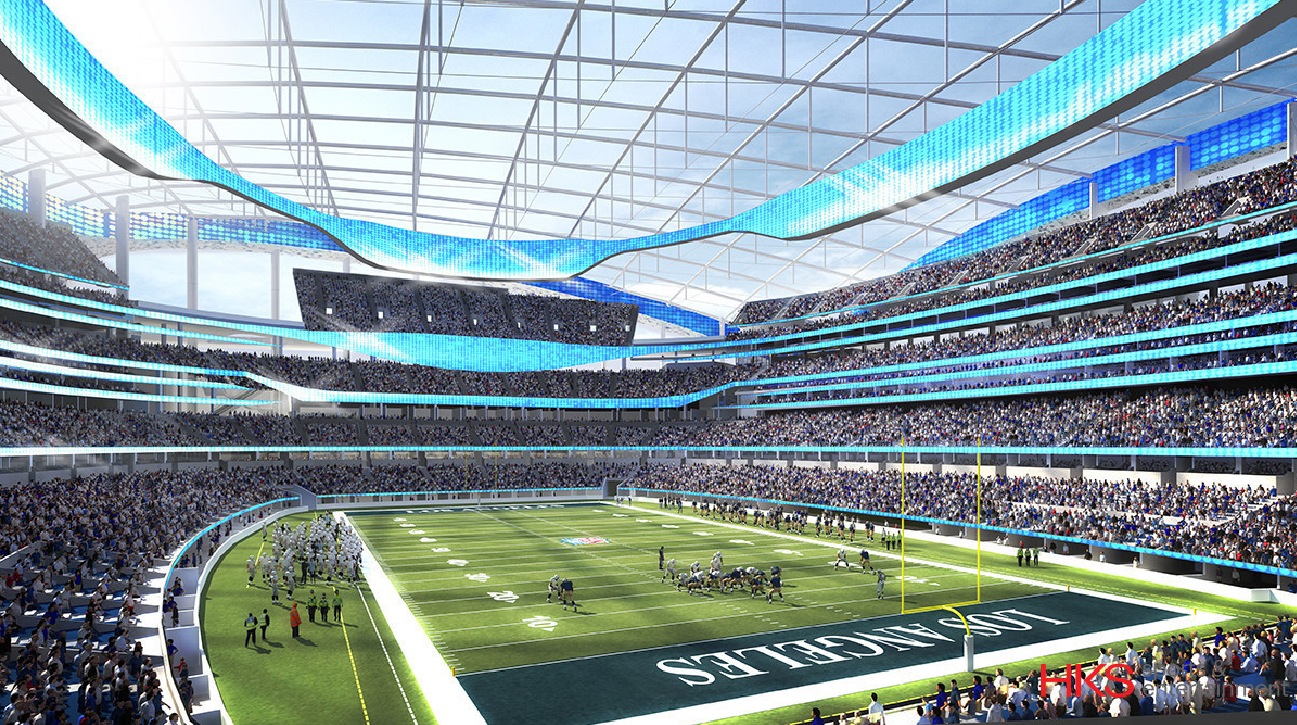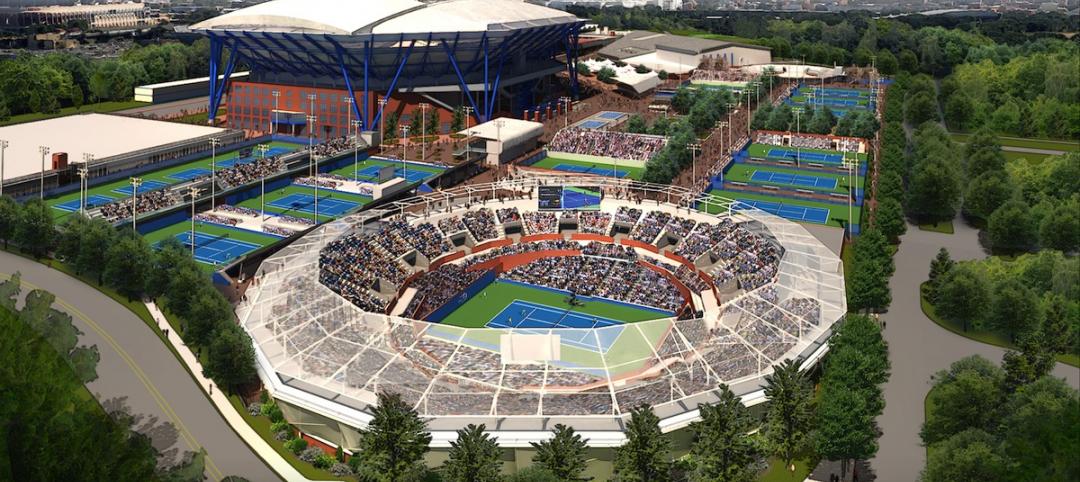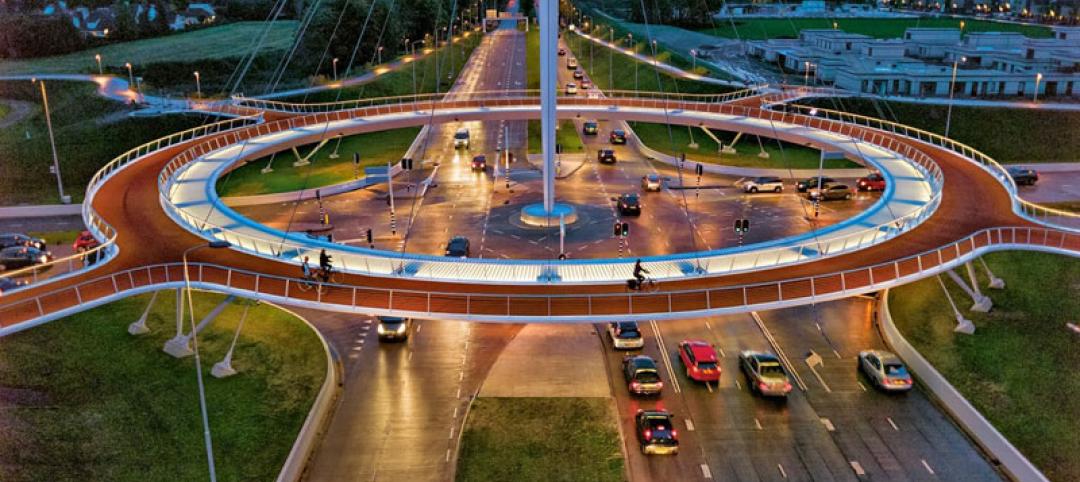After years of rumors and speculation, and with plenty of moving parts that still need to be sorted out, at least one thing is official: the St. Louis Rams are Los Angeles-bound.
The NFL owners voted in favor of the Rams’ plan of moving back to the city they called home from 1946 to 1994.
A new stadium will be built in Inglewood, Calif., on the site of the old Hollywood Park racetrack, roughly 10 miles from downtown Los Angeles. It is expected to be the league’s largest stadium in terms of area (at 8.5 million sf), and will cost between $1.8 billion and $3 billion.
The stadium will be set 100 feet into the ground with a 175-foot above ground profile. The roof will have open air on its sides with metal borders at the top, and the section over the playing field will be made of the transparent ETFE material, which is translucent but immensely strong. The stadium, which will have 70,000 seats and could expand to 100,000 with standing room only capacity, will be part of a 298-acre entertainment, retail, and housing complex.
“It's going to be so much more than going to a football game,” said Mark Williams of HKS, the firm designing the stadium, according to the Los Angeles Times. “You're going to be absorbed into the site, absorbed into the stadium, and get a very wide bandwidth of experience. It's the kind of memory people are going to cherish for a lifetime.”
The NFL is in favor of two teams moving to LA and sharing a stadium. The San Diego Chargers have the option of leaving their digs, the old Qualcomm Stadium, and joining the Rams in becoming co-tenants at the new LA stadium. They have a little more than one year to make a decision. If they decline, then the Oakland Raiders could choose to move from their home, the O.co Coliseum, and play in the new stadium with the Rams.
Meanwhile, both the Chargers and Raiders are working to stay in their current cities (at least that's what both teams’ owners are saying). If they stay, the NFL will give them each $100 million toward a new stadium.
The original plan for the Raiders and Chargers was for the teams to share a stadium, designed by Manica Architecture, in Carson, Calif. That was voted down by the owners in part because of logistics (the league would’ve had to realign divisions), and in part due to location. The $1.7 billion stadium in Carson would’ve been built on top of an old landfill.
 The proposed Carson Stadium was voted down by NFL owners. Rendering: Manica Architecture
The proposed Carson Stadium was voted down by NFL owners. Rendering: Manica Architecture
The next step for the Rams will be to determine where they’ll play next. The team’s temporary home is expected to be the LA Coliseum, a 92-year-old bowl stadium that seats more than 93,000 people. The University of Southern California’s football team currently plays there on Saturdays. Other options for the Rams include the Rose Bowl in Pasadena and Angel Stadium of Anaheim.
Los Angeles has been without football since the 1994 season, when both the Rams and Raiders moved. For the 1995 season, the Rams played at St. Louis’s Busch Stadium before moving into the now-named Edward Jones Dome later in the season. The Rams stayed at the dome through the 2015 season.
The Rams turned down a recent plan to stay in St. Louis, which included a $1 billion HOK-designed stadium on the Mississippi River.
Though financing was an issue for the proposed St. Louis stadium, it’s unclear how serious the team considered the plan. Rams’ owner Stan Kroenke bought the land in Inglewood back in early 2014, which had fueled relocation rumors since.
 The proposed riverfront stadium in St. Louis. Rendering: HOK
The proposed riverfront stadium in St. Louis. Rendering: HOK
Related Stories
| Apr 2, 2014
8 tips for avoiding thermal bridges in window applications
Aligning thermal breaks and applying air barriers are among the top design and installation tricks recommended by building enclosure experts.
| Mar 26, 2014
Callison launches sustainable design tool with 84 proven strategies
Hybrid ventilation, nighttime cooling, and fuel cell technology are among the dozens of sustainable design techniques profiled by Callison on its new website, Matrix.Callison.com.
| Mar 25, 2014
Sydney breaks ground on its version of the High Line elevated park [slideshow]
The 500-meter-long park will feature bike paths, study pods, and outdoor workspaces.
| Mar 20, 2014
Common EIFS failures, and how to prevent them
Poor workmanship, impact damage, building movement, and incompatible or unsound substrate are among the major culprits of EIFS problems.
| Mar 13, 2014
Do you really 'always turn right'?
The first visitor center we designed was the Ernest F. Coe Visitor Center for the Everglades National Park in 1993. I remember it well for a variety of reasons, not the least of which was the ongoing dialogue we had with our retail consultant. He insisted that the gift shop be located on the right as one exited the visitor center because people “always turn right.”
| Mar 12, 2014
14 new ideas for doors and door hardware
From a high-tech classroom lockdown system to an impact-resistant wide-stile door line, BD+C editors present a collection of door and door hardware innovations.
| Feb 26, 2014
Billie Jean King National Tennis Center serving up three-phase expansion
The project includes the construction of two new stadiums and a retractable roof over the existing Arthur Ashe Stadium.
| Feb 14, 2014
First look: Kentucky's Rupp Arena to get re-clad as part of $310M makeover
Rupp Arena will get a 40-foot high glass façade and a new concourse, but will retain many of its iconic design elements.
| Feb 14, 2014
Crowdsourced Placemaking: How people will help shape architecture
The rise of mobile devices and social media, coupled with the use of advanced survey tools and interactive mapping apps, has created a powerful conduit through which Building Teams can capture real-time data on the public. For the first time, the masses can have a real say in how the built environment around them is formed—that is, if Building Teams are willing to listen.
| Feb 11, 2014
World's first suspended bicycle roundabout [slideshow]
Located in the Netherlands, the project was designed to promote a healthier lifestyle.

















